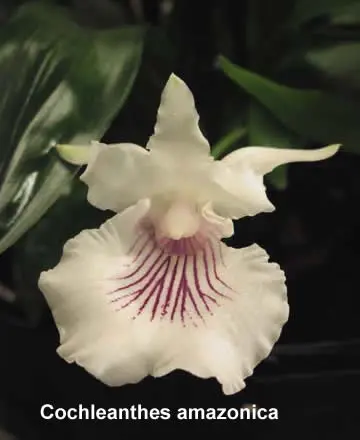 |
||
| Cochleanthes
Ther are 15 species distributed from Peru to Costa Rica. These pants grow in the cloud forests as ephiphytes, so they like it wet, and so reward the grower with single but successive flowerings throughout the year. |
||
| Cochleanthes amazonica Occuring in the Amazon basin, this plant produces the largest flowers of the genus, some 75 cm. The flowers are white with purple vein lines in the lip. |
||
| /\ Top of Page | ||
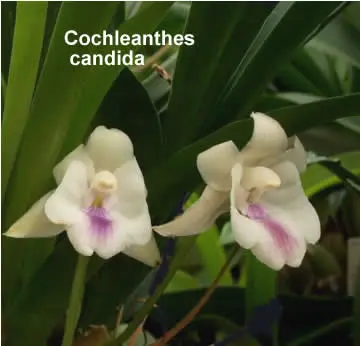 |
||
| Cochleanthes
Ther are 15 species distributed from Peru to Costa Rica. These pants grow in the cloud forests as ephiphytes, so they like it wet, and so reward the grower with single but successive flowerings throughout the year. |
||
| Cochleanthes candida These plants are epiphytes from the cloud forest that like intermediate conditions and plenty of moisture. Although the flowers appear singly, can appear throughout the year, more during summer and fewer in winter. Definitely no dry winter rest. |
||
| /\ Top of Page | ||
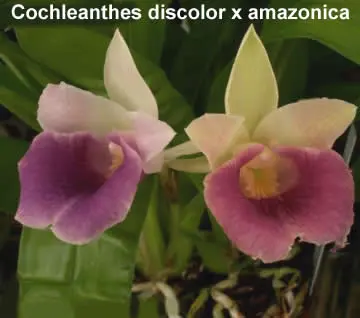 |
||
| Cochleanthes
Ther are 15 species distributed from Peru to Costa Rica. These pants grow in the cloud forests as ephiphytes, so they like it wet, and so reward the grower with single but successive flowerings throughout the year. |
||
| Cochleanthes discolor x amazonica These plants are epiphytes from the cloud forest that like intermediate conditions and plenty of moisture. Although the flowers appear singly, can appear throughout the year, more during summer and fewer in winter. Definitely no dry winter rest. |
||
| /\ Top of Page | ||
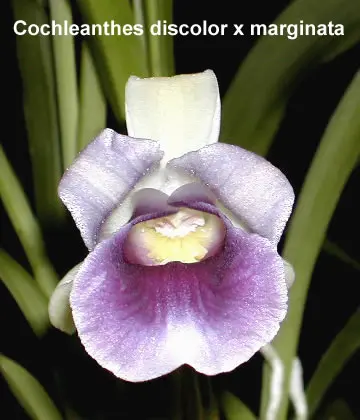 |
||
| Cochleanthes
Ther are 15 species distributed from Peru to Costa Rica. These pants grow in the cloud forests as ephiphytes, so they like it wet, and so reward the grower with single but successive flowerings throughout the year. |
||
| Cochleanthes discolor x marginata These plants are epiphytes from the cloud forest that like intermediate conditions and plenty of moisture. Although the flowers appear singly, can appear throughout the year, more during summer and fewer in winter. Definitely no dry winter rest. |
||
| /\ Top of Page | ||
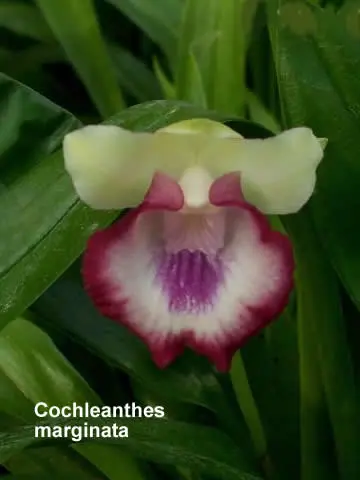 |
||
| Cochleanthes
Ther are 15 species distributed from Peru to Costa Rica. These pants grow in the cloud forests as ephiphytes, so they like it wet, and so reward the grower with single but successive flowerings throughout the year. |
||
| Cochleanthes marginata These plants are epiphytes from the cloud forest that like intermediate conditions and plenty of moisture. Although the flowers appear singly, can appear throughout the year, more during summer and fewer in winter. Definitely no dry winter rest. |
||
| /\ Top of Page | ||
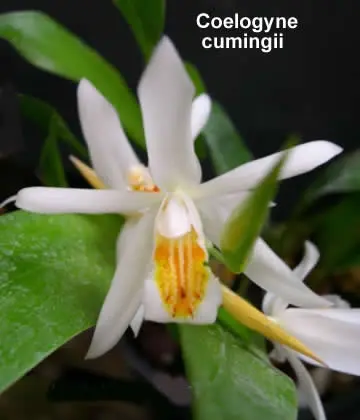 |
||
| Coelogyne
Thera are over 100 species in this genus, and they are distributed from India to as far south as Fiji. There are cool growing species which require dry winter rest and lower temperatures to encourage flower bud formation. Warm species can be watered and fed throughout the year. |
||
| Coelogyne cumingii Warm growing epiphyte that blooms in spring & summer. The inflorescence carries several fragrant white to cream with gold lip flowers. |
||
| /\ Top of Page | ||
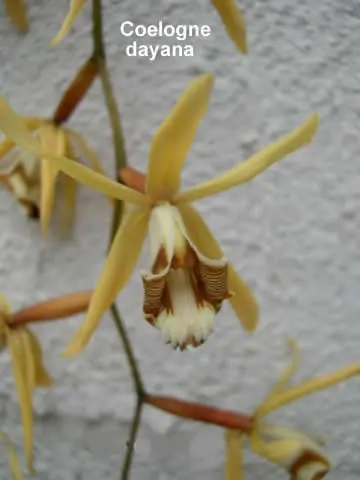 |
||
| Coelogyne
Thera are over 100 species in this genus, and they are distributed from India to as far south as Fiji. There are cool growing species which require dry winter rest and lower temperatures to encourage flower bud formation. Warm species can be watered and fed throughout the year. |
||
| Coelogyne dayana Native to the island of Borneo, this beautiful species has tapered conical pseudobulbs that are 28cm long. The bifoliate, long, stiff, pleated leaves are about 50cm in length. The flower spikes emerge several times per year and can be up to three feet or more in length. The flowers have a pleasant fragrance. |
||
| /\ Top of Page | ||
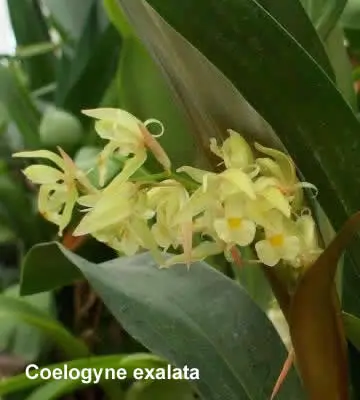 |
||
| Coelogyne
Thera are over 100 species in this genus, and they are distributed from India to as far south as Fiji. There are cool growing species which require dry winter rest and lower temperatures to encourage flower bud formation. Warm species can be watered and fed throughout the year. |
||
| Coelogyne exalata A native of Borneo |
||
| /\ Top of Page | ||
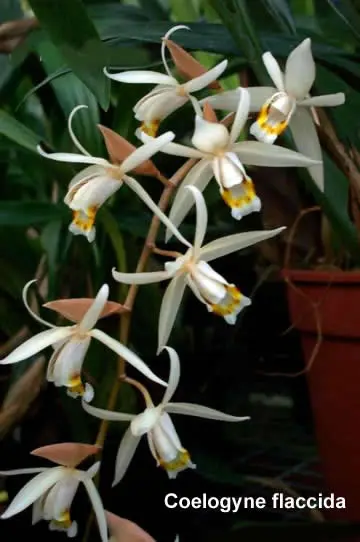 |
||
| Coelogyne
Thera are over 100 species in this genus, and they are distributed from India to as far south as Fiji. There are cool growing species which require dry winter rest and lower temperatures to encourage flower bud formation. Warm species can be watered and fed throughout the year. |
||
| Coelogyne flaccida Nepal, Northeast India (Himalayas, Sikkim, Khasia Hills), Burma, China (Yunnan), Laos, Vietnam, Thailand. Flowers February to May. |
||
| /\ Top of Page | ||
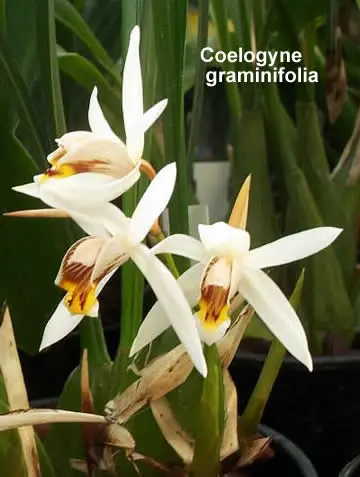 |
||
| Coelogyne
Thera are over 100 species in this genus, and they are distributed from India to as far south as Fiji. There are cool growing species which require dry winter rest and lower temperatures to encourage flower bud formation. Warm species can be watered and fed throughout the year. |
||
| Coelogyne graminifolia synonym of Coelogyne viscosa. Distributed from Assam to China (SW. Yunnan) and Pen. Malaysia. A Pseudobulb epiphyte growing on the intermediate side with moderate light. Likes lots of water in its growing period. Produces 5 - 6 flowers per inflorescence during late spring into summer. |
||
| /\ Top of Page | ||
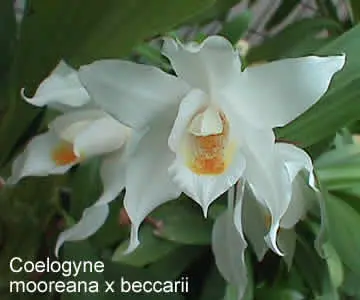 |
||
| Coelogyne
Thera are over 100 species in this genus, and they are distributed from India to as far south as Fiji. There are cool growing species which require dry winter rest and lower temperatures to encourage flower bud formation. Warm species can be watered and fed throughout the year. |
||
| Coelogyne mooreana x beccarii Both species from Vietnam, no more details. |
||
| /\ Top of Page | ||
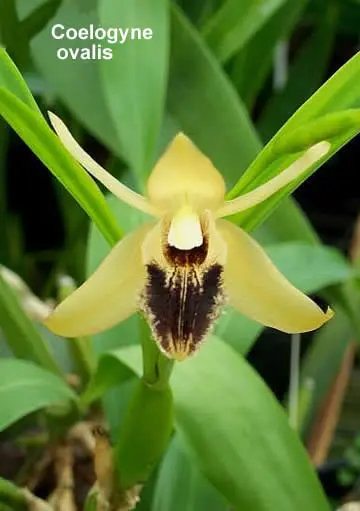 |
||
| Coelogyne
Thera are over 100 species in this genus, and they are distributed from India to as far south as Fiji. There are cool growing species which require dry winter rest and lower temperatures to encourage flower bud formation. Warm species can be watered and fed throughout the year. |
||
| Coelogyne ovalis Ranging from Himalaya to China and Indo-China. An easy to grow species requiring intermediate temperatures. |
||
| /\ Top of Page | ||
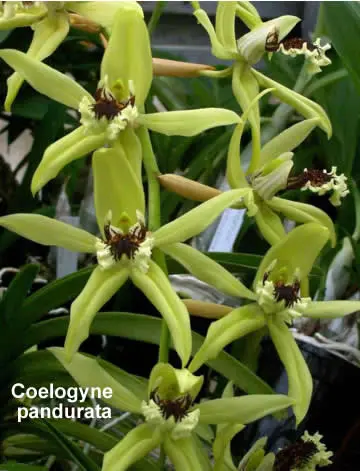 |
||
| Coelogyne
Thera are over 100 species in this genus, and they are distributed from India to as far south as Fiji. There are cool growing species which require dry winter rest and lower temperatures to encourage flower bud formation. Warm species can be watered and fed throughout the year. |
||
| Coelogyne pandurata Distributed from Malaya, Sumatra, Borneo, and the Philippines on Mindanao, Luzon and Samar Islands. They generally grow on old trees by rivers, near the coast, or in hot, damp, swampy lowlands.Fragrant flowers up to 120mm across and up to 15 per inflorescence, on well grown plants. |
||
| /\ Top of Page | ||
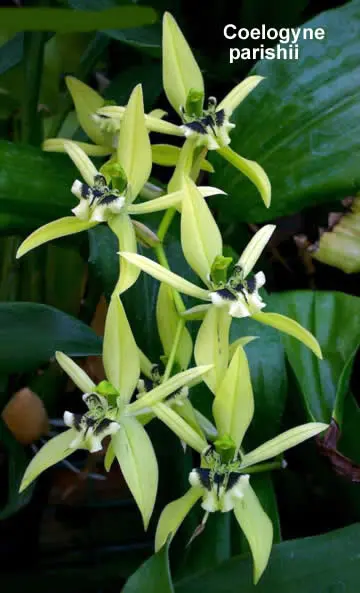 |
||
| Coelogyne
Thera are over 100 species in this genus, and they are distributed from India to as far south as Fiji. There are cool growing species which require dry winter rest and lower temperatures to encourage flower bud formation. Warm species can be watered and fed throughout the year. |
||
| Coelogyne parishii Lower Burma. Flowering March-June. they need warm to Intermediate conditions similar to pandurata, but has smaller flowers and less lip ornamentation. |
||
| /\ Top of Page | ||
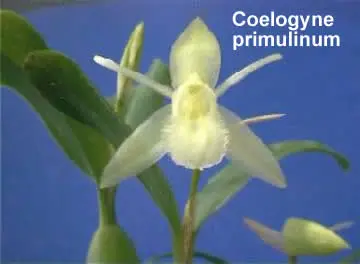 |
||
| Coelogyne
Thera are over 100 species in this genus, and they are distributed from India to as far south as Fiji. There are cool growing species which require dry winter rest and lower temperatures to encourage flower bud formation. Warm species can be watered and fed throughout the year. |
||
| Coelogyne primulinum | ||
| /\ Top of Page | ||
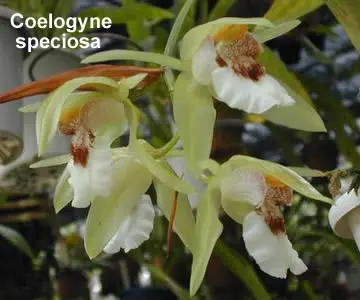 |
||
| Coelogyne
Thera are over 100 species in this genus, and they are distributed from India to as far south as Fiji. There are cool growing species which require dry winter rest and lower temperatures to encourage flower bud formation. Warm species can be watered and fed throughout the year. |
||
| Coelogyne speciosa Distributed throughout Malaysia, Borneo, Sumatra and Java. This sympodial epiphyte needs cool to intermediate temperatures. Can flower year round but most heavily in spring. |
||
| /\ Top of Page | ||
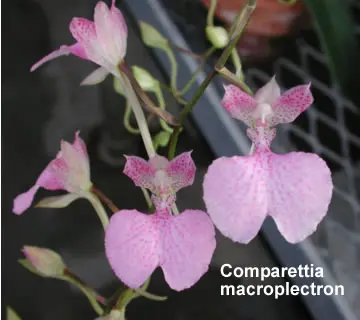 |
||
| Coelogyne
Over 100 species strong this genus is distributed from India to China adn from Indonesia to the Fiji islands. Racemes of flowers grow from the top of the psuedobulbs. There are both intermediate species and cool growing species (which like a rest when the bulb mature). |
||
| Comparettia macroplectron A native of Colombia this pseudobulb(very smallbulb) epiphyte is a minature the leaves being 7cm long the flowers 3.5cm wide. Nice on bark or slab of tree fern. |
||
| /\ Top of Page | ||
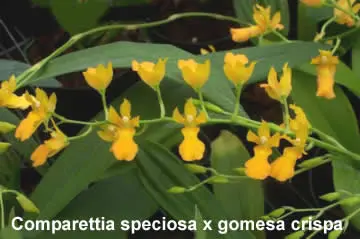 |
||
| Coelogyne
Over 100 species strong this genus is distributed from India to China adn from Indonesia to the Fiji islands. Racemes of flowers grow from the top of the psuedobulbs. There are both intermediate species and cool growing species (which like a rest when the bulb mature). |
||
| Comparettia speciosa x gomesa crispa A south american mix |
||
| /\ Top of Page | ||
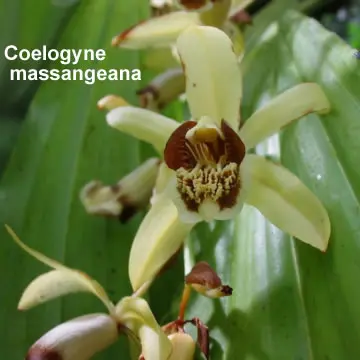 |
||
| Coelogyne
Thera are over 100 species in this genus, and they are distributed from India to as far south as Fiji. There are cool growing species which require dry winter rest and lower temperatures to encourage flower bud formation. Warm species can be watered and fed throughout the year. |
||
| Coelogyne massangeana Distributed through Malaysia, Java, Borneo and Sumatra. A fragrantly scented flowering plant that requires moderate light and good air movement. A regular watering schedule and |
||
| /\ Top of Page | ||